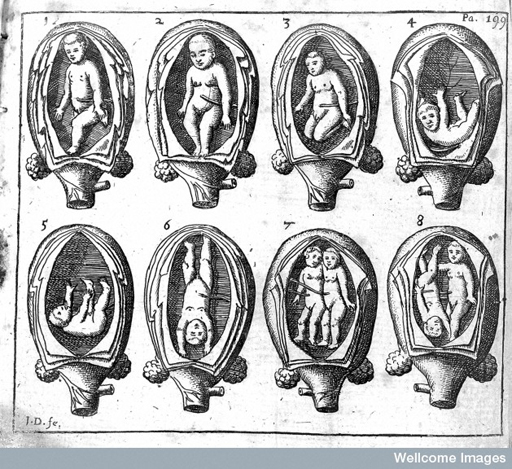1.4 Developing in the womb
As you learned in A regimen for everyone [Tip: hold Ctrl and click a link to open it in a new tab. (Hide tip)] in Week 3, digestion was understood by ancient Greeks and Romans as a form of internal ‘cooking’. Similar images were used to understand what happened during conception and beyond.
A Hippocratic treatise of around 430–420 BCE (On Generation/Nature of the Child) describes how the foetus grew in the womb, and in particular how ‘breath’ (pneuma) entered the mixture of male and female seeds to make it rise like bread dough, forming a membrane. Imagery was not just taken from baking, but from agriculture and the natural world. In myth, Erichthonios was born from Gaia, the earth goddess. Many ancient Greek cities had myths in which their first inhabitants were born from the earth. The imagery continued in the classical Athenian marriage ceremony, in which a man gave his daughter to her future husband ‘for the ploughing of legitimate children’.
Medical writers drew on this imagery. Inside the womb, the growing foetus put out ‘branches’ – the limbs, and subsequently the fingers and toes. The author of On Generation/Nature of the Child also draws parallels between human gestation and that of animals; for example, both pregnant women and cows about to have a calf put on extra fat. This treatise contains two different theories of seed production in the body. In one, the seed comes from the head and travels down the spinal cord; in the other, seed comes from all over the body, and this explains why a person may have some features of one parent, but also features from the other parent.

The same treatise also explains the birth of children with disabilities. Weak babies may be the result of the mother’s womb being too open, so that the blood needed to make them grow is lost. Alternatively, the womb may be too small. The writer asks the reader to imagine a cucumber growing in a jar; it will grow into the shape of its container. Further disabilities are described as the result of injury to the mother. Disabled parents, however, usually produced healthy children, unless there was damage to their ‘seed’:
When some disease befalls the moisture from which the sperm is formed, the four kinds of substances that are naturally present in this part do not produce a complete seed, but one weaker to the degree that it is maimed; thus it does not seem any wonder to me that this offspring is maimed like its parent.
You will return to disability in Week 6.
Premature birth was also discussed by medical writers. A pair of treatises from the early fourth century BCE look at the ‘seven months child’ and the ‘eight months child’ – because the ancient Greeks counted ‘inclusively’, this means children born after six months and seven months in the womb have been completed. The writer is pessimistic about these premature births, but says that the ‘seven months child’ is more likely to live than the ‘eight months child’. Again, agricultural imagery features:
Now as a fetus arrives at the onset of its final formation, it matures and gains much strength in the process, more than at any other time; the membranes in which it is nourished in the beginning become loose, just the way that ears of grain do when they are stretched before their fruit has reached its complete maturity.
The emerging baby is thought to be the active element here, as it ‘breaks through its membranes’ and ‘compels’ birth to occur; elsewhere in the ancient Greek medical texts, the image of a chick pecking its way out of an egg features.
The explanation for the ‘seven months child’ being more likely to live was that it emerged before a period of 40 days, during which the Greeks believed that the child changed position in the womb so that it emerged (normally) head-first. This period was seen as a very dangerous one and is even described as an ‘illness’, because access to both food and ‘breath’ was restricted while the child moved.
